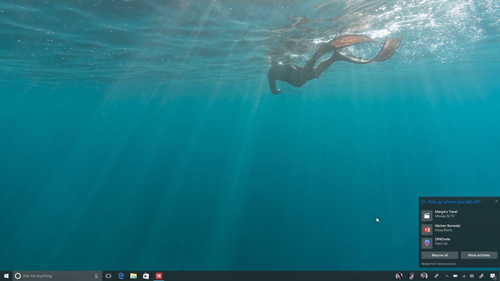News
Microsoft Build 2017: Windows 10 Fall Creators Update Announced
- By Scott Bekker
- 05/11/2017
Microsoft announced the next major update to Windows 10, arriving sometime this fall, on the second day of the company's Build developer conference in Seattle, Wash.
The release will build on the Windows 10 Creators Update that became available last month. The new update is slated for release "later this year." For Windows Insiders, a preview build (16193) of Windows 10 Creators Update was made available on Thursday.
Much like the original Creators Update, the focus will be on improving an individual's ability to be creative using photos, video, sound and effects, with a special emphasis this time on 3-D and mixed reality. However, some of the new features should deliver productivity enhancements for more traditional PC users.
One of the new features is called Timeline, which is a visual display using a card-style interface that allows a user to see a history of previous activities and hop back and forth among them.
 [Click on image for larger view.] The new Timeline feature in the coming Fall Creators Update.
[Click on image for larger view.] The new Timeline feature in the coming Fall Creators Update.
Another new general-purpose feature is a cloud-powered Clipboard, which will allow users to copy something on one device and paste it into another. In an example from the Build stage, Joe Belfiore copied the name of a business from a PowerPoint deck on a PC, and pasted it into a mapping app on an Android phone. The phone was running Microsoft's SwiftKey keyboard, which provided the prompt to paste from the cloud Clipboard.
Another new general-purpose feature with the very WYSIWYG name, "Pick Up Where You Left Off," will allow users to continue a task from Windows in iOS or in Android. The other major feature in the general-purpose category previewed on Thursday was a OneDrive Files on Demand capability that will attempt to minimize per-device storage requirements by only bringing down cloud files as they are used.
 [Click on image for larger view.] In the upcoming Fall Creators Update, Cortana will ask users if they want to pick where they left off.
[Click on image for larger view.] In the upcoming Fall Creators Update, Cortana will ask users if they want to pick where they left off.
In video clips, Microsoft showed students taking photographs of objects in the real-world with their devices, converting them into 3-D renderings, mixing them with other videos or photographs, and creating integrated videos. Undergirding the demonstrations was a Windows 10 Fall Creators Update-era Universal Windows Platform (UWP) application called Windows Story Remix, which is built on .NET and will be distributed through the Windows Store.
On the mixed reality side, Microsoft unveiled a new category of hardware devices for its platform. In addition to the ability to pre-order Acer and HP mixed reality headsets from the Windows Store, Microsoft showed off new mixed reality motion controllers that can be paired with the headsets. Users hold a controller in each hand to manipulate objects and navigate interfaces that are visible through a headset. The controllers have a trigger, a grab button, a thumbstick, a small touchpad and optical tracking.
Terry Myerson, executive vice president of the Windows and Devices Group, used his keynote to trumpet some application wins for the Windows Store.
Apple iTunes will hit the Window Store by the end of the year. Autodesk will roll out a UWP version of Autodesk Stingray, a 3-D game and real-time rendering engine with support for Windows Mixed Reality. Later this month, SAP will publish in the Windows Store its SAP Digital Boardroom, which is a dashboard for monitoring business data. Bash on Ubuntu for Windows is now available in the Windows Store, and Microsoft is working with SUSE Linux and Fedora Linux to bring other Linux offerings to the Windows Store.
For developers, Microsoft will update Visual Studio Mobile Center with new UWP capabilities this fall, including automated build support and new Windows devices in a test cloud.
Microsoft also confirmed a key installed base metric that has been circulating this week ahead of the show. Windows 10 is now on 500 million devices, which is halfway to Microsoft's publicly stated goal of getting Windows 10 on 1 billion devices worldwide. Myerson provided some context about how many people are using those devices and for how long each day: "It's exciting to see more than 300 million people using Windows 10 every day for more than 3.5 hours a day on average."
About the Author
Scott Bekker is editor in chief of Redmond Channel Partner magazine.